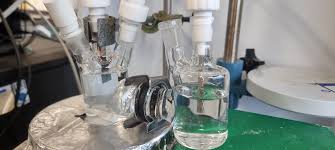Researchers at Johannes Gutenberg University Mainz (JGU) developed an innovative solution to this problem by turning CO2 to ethanol, a renewable resource for chemical uses. “We can remove the greenhouse gas CO2 from the environment and reintroduce it into a sustainable carbon cycle,” stated Professor Carsten Streb of the JGU Department of Chemistry. This development in electrocatalysis enables CO2 efficiently converted into ethanol, paving the path for green and sustainable energy sources while also freeing up vital agricultural resources for food production.
CO2 to Ethanol: A Breakthrough in Electrocatalysis
The electrochemical conversion of CO2 into multicarbon molecules such as ethanol is a breakthrough solution. Ethanol, a high energy density fuel, not only acts as a raw material for chemical manufacturing, but it also helps to lower CO2 levels in the atmosphere. However, in order to obtain high ethanol selectivity, this process requires specific catalysts. The researchers’ newly created system achieves these requirements by converting CO2 to ethanol with up to 80% selectivity, a significant improvement over earlier methods.
The researchers developed a customized electrode coated in a black powder of cobalt and copper. These metals must be precisely placed on the electrode in order to catalyze the reaction properly. Streb explained the challenge: “The first task is to get CO2 to react since the links in its molecular structure are extremely strong. Cobalt can disrupt these bonds, resulting in carbon monoxide as an intermediate.” In the following phase, copper converts this carbon monoxide, which is unsuitable for chemical activities, into ethanol. This two-step process requires cobalt and copper to be close to one other on the electrode surface.
Improving Selectivity and Efficiency in the CO2 to Ethanol Process
Currently, the selectivity of this method is around 80%, a record high in this field of research. However, the team, including main author Dr. Soressa Abera Chala of Ethiopia, is aiming to improve the catalyst’s effectiveness even more. Chala and his colleagues at JGU hope to raise selectivity to 90-95% and eventually build a catalyst with 100% selectivity, producing only ethanol with no byproducts.
The team’s research is part of the Collaborative Research Center / Transregio “CataLight” (CRC/TRR 234), which collaborates with Ulm University. Their primary goal is to improve control over catalyst behavior, particularly accurate cobalt and copper loading on the electrode. They use electron microscopy to study individual atoms on the electrode surface in order to enhance catalyst efficiency and durability, ensuring stability over long periods of use.
Collaborative Research Efforts to Ensure Catalyst Durability and Stability
This CO2 to ethanol conversion is strongly dependent on precisely controlled reaction conditions and rigorous electrode design. Stability is a priority because constant performance needed for large-scale applications. As part of the “CataLight” cooperation endeavor, JGU and Ulm University scientists hope to develop a catalyst that can remain effective for months without losing performance. The technology’s scalability and commercial feasibility rely heavily on its stability.
Affordable and Abundant Materials: the choice of Cobalt and Copper
One notable advantage of this strategy is the use of non-precious metals such as cobalt and copper, both of which are abundant and inexpensive. Although other metals, such as platinum and palladium, could catalyze this process, they are too expensive for widespread commercial application. By focusing on cobalt and copper, researchers are in line with current sustainable research trends that highlight the use of low-cost, easily accessible minerals. The abundance of these metals on Earth supports the viability of scaling this method.
Applications for the Sustainable Carbon Cycle and Food Security
One of the most intriguing elements of this technology is its ability to create ethanol from renewable energy sources, such as green electricity, while reducing CO2 emissions from power plants or industrial processes. Currently, enormous amounts of ethanol produced from commodities like sugar cane and maize, particularly in Brazil. This not only depletes agricultural resources but also reduces the availability of these crops as food. This new technology allows for the sustainable sourcing of ethanol without diverting the food supply, thereby boosting both food security and environmental sustainability.
Future Prospects: Decentralized Power Generation and Energy Storage
Looking ahead, this technology has the potential to revolutionize dispersed power generation. Ethanol, created sustainably from CO2 and renewable electricity, might be stored and used as needed for local power generation, benefiting places with limited access to centralized energy networks. The implications for renewable energy are significant, as ethanol can be a clean, high-density energy source to supplement intermittent renewable sources such as wind and solar power.
Conclusion
The JGU research team’s novel CO2 to ethanol method is a promising step toward minimizing the effects of climate change. By combining electrocatalysis with low-cost ingredients, the process recycles CO2 into ethanol, offering a sustainable raw source for a variety of uses while lowering dependency on agricultural crops. This technology, which is supported by joint research activities, has the potential for widespread implementation, contributing to a circular carbon economy and creating a greener, more sustainable future.

